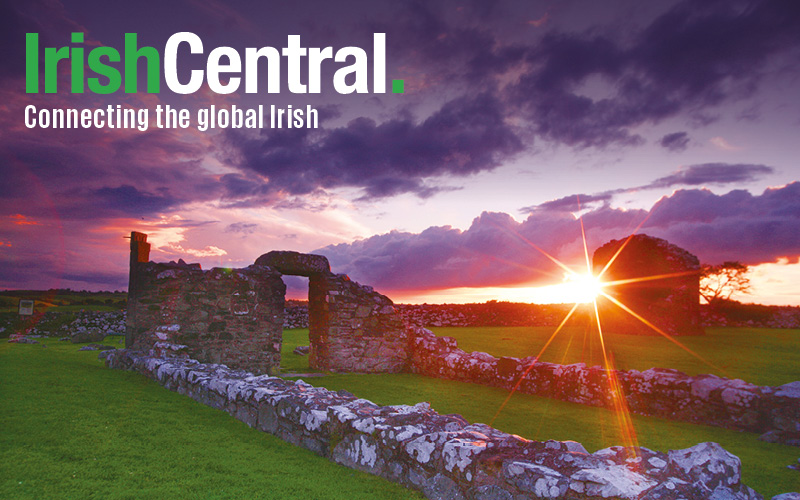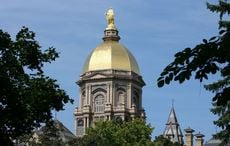When John L. Lahey was a boy, he once accompanied his father, a hard-working bricklayer, to a worksite. He wanted to see what his father’s job was all about, and to try it out for himself. His grandfather, Daniel Lahey, an immigrant from Knockglossmore, Co. Kerry, had been a stone mason, so the craft was in the family.
After a few unsuccessful attempts by Lahey to learn the trade, his father asked him to stop. It was fairly clear that his future didn’t lie in masonry. On the way back to their home in the Riverdale section of the Bronx, the elder Lahey advised his son. “You’re smart,” he said. “I think your future is in education.”
As it turns out, he was right.
For the past 24 years, Lahey has been president of Quinnipiac University in Hamden, Connecticut. During his tenure there, the university’s academic programs, facilities, enrollment, national ranking and prestige have grown at an unprecedented rate. One semester each year, Dr. Lahey returns to the classroom with his PhD in Philosophy, teaching a course on logical reasoning or social and political philosophy. In addition to his work as university president, Lahey devotes significant time to his Irish roots. He has been involved with the NYC St. Patrick’s Day Parade since he was a child, and currently serves as vice chairman of the parade committee. Lahey has also worked thoughtfully and tenaciously to correct what he openly calls the “whitewashing” of the true story of Ireland’s great hunger from the history books and from cultural memory: namely, that it could have been prevented and that idleness on the part of the British was largely to blame for the magnitude of the famine’s devastation. Though he may not have been very good at literal bricklaying, Lahey has proven to be a master at a more conceptual sort of building.
The university president is the first to admit that he has always been more intellectually inclined. Thirsty for knowledge from a young age, Lahey attended the Fordham Preparatory School in Riverdale. “In a way,” he reflected during a recent visit to the Irish America offices, “we studied philosophy without calling it philosophy: we took theology courses and asked where the world had come from and where it was going – great, essential philosophical questions. I had an interest in those big questions from an early age.”
He was also very involved in the community, spending each St. Patrick’s Day marching in the New York City parade under Fordham University’s banner. He loved New York and he loved St. Margaret’s Parish, the very Irish enclave where his family lived. But when it was time to choose a college, Lahey made the tough decision to leave his city and attend the University of Dayton, Ohio.
Lahey found his niche when he enrolled in his second philosophy course at Dayton. The class explored the philosophy of St. Thomas Aquinas, and little else. “At this point,” he explained “it was still 1964 or ’65, and only certain types of philosophy were officially taught. Since Dayton was a Catholic university, they were still only teaching the traditional philosophy of St. Thomas Aquinas, upon which much of Catholic theology is based. There was a whole index of banned works they weren’t allowed to teach: essentially, anything that was deemed to be inconsistent with St. Thomas Aquinas or Catholic doctrine.”
However, Lahey wound up learning much more than the approved Thomistic philosophy. “Another student and I were asking a lot of questions in class,” he recalled. “We didn’t want to get Professor Balthasar in trouble, but we were curious about how to reconcile scientific thought with Catholic doctrine. One day, he asked us both to stay after class, and he said ‘Look, you two. I’ll give you an A for the course, you know what you’re doing in terms of St. Thomas Aquinas. You don’t have to come to class for the rest of the semester, but come to my office and I’ll teach you the philosophy of Pierre Teilhard de Chardin. I can’t teach you this officially in the classroom but there’s nothing to prevent you from reading the books.’
“So he gave me two of his books: Phenomenon of Man and The Divine Milieu. And it was exactly what I had been looking for. The author, Pierre Teilhard de Chardin, was somewhat of a contradiction at that time: he was a Jesuit priest, a philosopher, and a scientist, and had written extensively about his belief that the creationist theories of how man, the world and the universe came into being could be reconciled with evolution; that Catholicism and the theory of evolution could co-exist. At the time, this was deemed to be totally inconsistent with Catholic teaching. But I was a young person, and evolution understandably had a lot of enticing aspects. Not only was it supported by a lot of scientists, Catholic and non-Catholic alike, but it was also a dynamic kind of philosophy that allowed for change. I had heard there was a contradiction between being a good Catholic and believing in evolution. But here was a brilliant scientist who was also a Jesuit priest! He used philosophical thought to combine the two things I wanted to combine in my own life. I was totally taken by it.”
Considering the carefully calculated percentages of students who meet with professors outside of class and student-to-faculty ratios in today’s college guides, this may not seem all that significant. But to Lahey, it was huge. “It’s harder to appreciate today, but back then, because of the time [the civil rights movement, the anti-war movement], the philosophy professors were among the most sought after teachers on any campus. They were dealing with war and peace; human rights and civil rights. For me it was a transformative experience and it was what led me to major in philosophy.” It also led him to stay on at Dayton for a master’s degree in the field, and then to the University of Miami, where he earned his PhD.
Lahey’s first teaching post was at a small college in Alabama. At this point, he had been away from New York for 13 years. In addition to all the philosophy he had studied during that time, he had also learned that he missed the Northeast and wanted to go back. A tough decision was in store as the professor of philosophy began to realize that it was unlikely he would return if he remained at the mercy of the tough academic job market. Determined to stay involved in the academy in some way, he returned to New York in 1977 and enrolled in a master’s course in academic administration at Columbia University. Upon graduating, he was quickly hired by Marist College in Poughkeepsie, New York, where he steadily climbed the ladder until he was named executive vice president.
After ten years with Marist, at the age of forty, Dr. Lahey was hired as President of Quinnipiac. It’s telling that, when asked what he is most proud of from his 24 years with the university, Lahey cannot name just one thing. “We’ve come so far,” he said with pride. When he started at Quinnipiac, it was still Quinnipiac College – a small, quiet commuter school. Today, it has a student population of about 8,000, with close to 6,000 undergraduate students, 2,000 graduate students, and 500 enrolled in the law school.
The law school is another of Quinnipiac’s great achievements. It was established under Lahey’s lead, when the law school at the University of Bridgeport closed and was restored by Quinnipiac. Lahey has also had a hand in the athletic teams’ entrance into the NCAA Division I Northeast Conference; the establishment of the highly regarded Quinnipiac Polling Institute; the wide expansion of the campus; and the school’s overall transition from a small college to a competitively ranked, nationally recognized university.
The next project is a medical school, which will employ the same philosophy the president has seen implemented in the school’s other programs: an emphasis on the actual practice of the subject being taught. “Take the law school, for instance,” Dr. Lahey explains. “Many of the top-ranked law schools in the country teach their students all there is to know about the law, but not as much about how to actually practice it. In a lot of cases that’s fine, since a significant number of their graduates go on to teach rather than practice. But I think it’s important that students know how to apply what they have learned to practical situations. That’s why the medical school will put an emphasis on primary care.”
There’s another thing that makes Quinnipiac stand out from the crowd. In the campus’s Arnold Bernhard Library, a special room designed to mimic the inside of a ship, houses the Lender Family Special Collection, one of the country’s largest collections of art and literature pertaining to An Gorta Mór – Ireland’s Great Hunger. It contains 700 volumes, historic and contemporary texts, and a growing number of works of art that portray or respond to the loss of more than 1.5 million Irish lives between the years of 1845 and 1852.
This is the common ground on which Lahey’s work as an educator and his commitment to his Irish roots come together. Growing up, he had always been aware of The Great Hunger and the shadow it cast over Irish history, but this was more of a peripheral awareness. “I knew about it, I had heard it talked about, but it was always called ‘The Famine,’ which doesn’t point to the truth of what happened.
True, there was a famine, the potato crops did fail for a few years, but that [alone] could not have caused the widespread death from starvation and related diseases. The untold story is that there was more than adequate food produced in Ireland during the years of the famine that could have been used to feed the Irish. But since Ireland was a part of the United Kingdom, the ports remained open for export.”
Lahey became fully aware of these facts in 1997, when he was honored as Grand Marshal of the NYC St. Patrick’s Day Parade. It was also the 150th anniversary of Black ’47, the deadliest year of the Great Hunger. Wanting to learn more, he read historian Christine Kinealy’s The Great Calamity, which revealed many facts about the Famine Lahey hadn’t known before.
“[She] really blew the lid off all of the inaccuracies and the dramatically downplayed scale of the tragedy,” he said. “She documented all kinds of food exports and found that the shipment of food out of Ireland actually increased during the years of the Famine. She also argued that much of the guilt and self-blame felt by the Irish was misplaced. For the greater part of 150 years, the world and the Irish believed that the Irish themselves had played some role in bringing about the famine. But the conditions of poverty and the disproportionate dependence on a single potato crop were imposed, over time, by the British. We now know that this was the greatest tragedy in 19th century Europe, and probably the greatest catastrophe in Ireland’s history, and it is all the more tragic because it was largely preventable.”
As an educator and an Irish-American, Dr. Lahey became determined to help correct the record. He used all of his speaking engagements as Grand Marshal to talk about the Great Hunger, and jumped at the opportunity when the brothers Murray and Marvin Lender (of the Lender’s Bagels family), who had been deeply moved by Lahey’s account, proposed forming a collection at Quinnipiac dedicated to An Gorta Mór.
With the Lender Family Collection and his advocacy of introducing a Great Hunger curriculum into public school systems, Lahey’s aim is to correct and accurately communicate the history of the Famine. “This is not just about commemorating what happened,” he emphasized, “we have to rewrite the history books and we have to rewrite the story that has been passed down from generation to generation of the Irish.”
One of the most notable components of the collection is its artwork. Within the Lender room, sculptures inspired by The Great Hunger are prominently displayed, and more are dispersed throughout the Bernhard Library. While Lahey is involved with all aspects of the collection, he takes a particular interest in the art, and reminisced about carrying the first piece he acquired for the collection, Roan Gillespie’s “The Victim,” with him on the flight back from Ireland. “It’s such a powerful work,” he said. “I didn’t want to let it out of my sight.”
For Lahey, art is a vital tool in re-shaping our understanding of the Famine because of its ability to impart essential information across many barriers. “In the long run history and education are extremely important, but there’s nothing more powerful for me than art. Art, like music, is a kind of universal language. You can bring anyone of any nationality or language into the Lender room. If they don’t speak or read English then they might not understand the words, but they can look at those images and the sculptures, and understand everything instantly.”
The Great Hunger collection continues to grow, and will soon be moved to its own space on Whitney Avenue, the main road that runs right from Hartford to New Haven. Lahey looks forward to this: “In its current location, the collection is in the middle of campus, a bit out of the way for anyone who wants to stop by and see it. It’s going to be so important for the whole collection to be on display in its own building. After all, its purpose is to educate, so the more accessible it is, the better.”
As vice chairman of the New York City St. Patrick’s Day Parade Committee, he keeps a very busy schedule in March. But his love of the parade runs deep – back to the years in high school when he marched behind Fordham’s banner. He has been volunteering with the parade for 30 years, and has held his current position on the committee for the past ten.
Dr. Lahey’s favorite thing about the parade is that its history mirrors that of the Irish in America. “It reflects how long the Irish have been a presence here and how far we have come.”
Though its history is of great significance, Lahey also feels that the parade itself has never been more important than it is today. “When I was a kid I thought everyone was Irish,” he said with a laugh. “This was because I grew up in a very Irish neighborhood. All my teachers were Irish, the police on the beat were all Irish, the firefighters were Irish, the other kids we played sports with were Irish, and so on. In that environment there were a lot of ways in which the Irish were able to pass on their history, culture, values and traditions to their kids, to the next generation in these Irish neighborhoods. But today, neighborhoods like that don’t really exist in New York in the way that they did then. Because they don’t, the parade is, at least for me, the single most concentrated event every year that brings the Irish together. It allows us to remember, celebrate, and pass on to the next generation what it means to be Irish, and what our struggles and accomplishments have been over the past 250 years in this country.”
His point is valid. But it must also be added that with people like Dr. John Lahey around, we won’t be forgetting our past, values, or traditions any time soon.




Comments